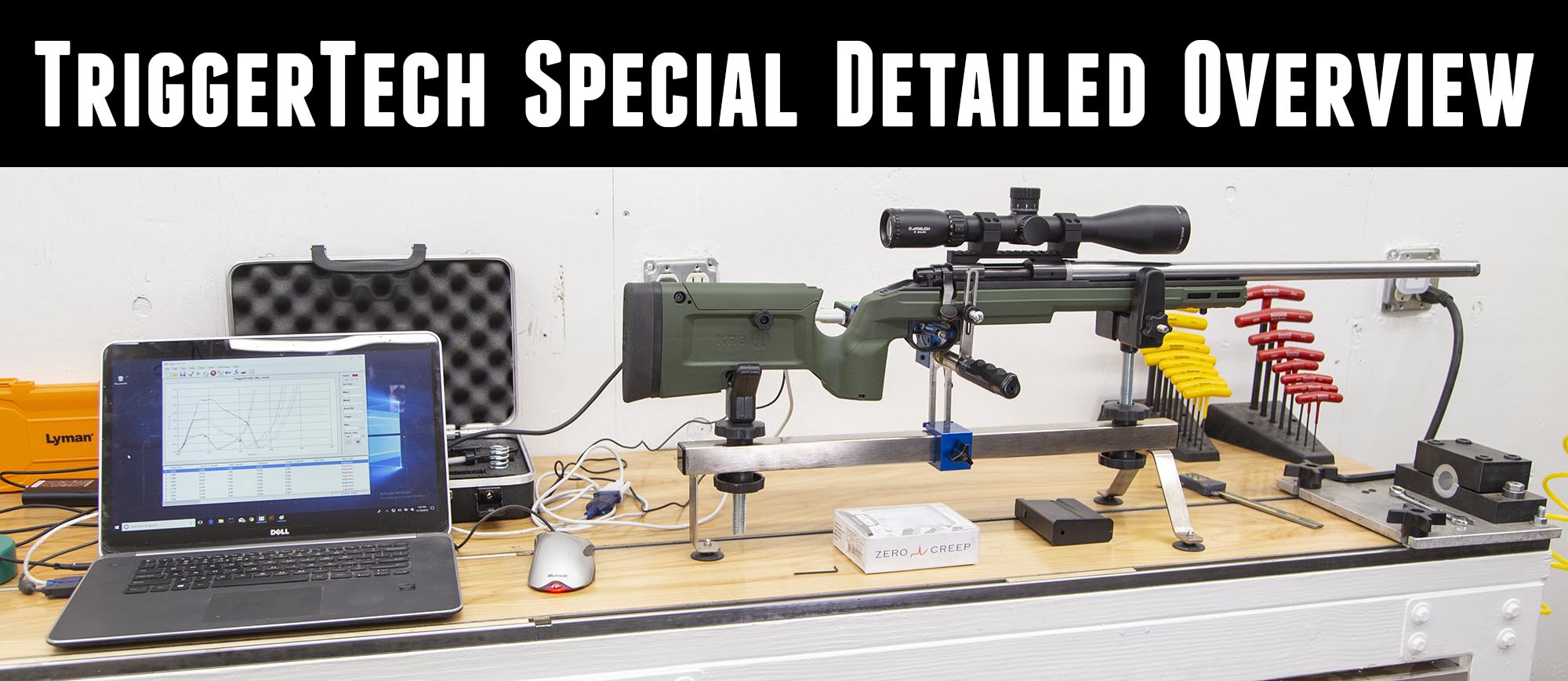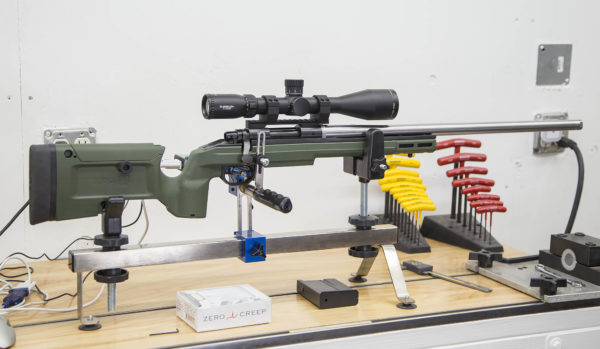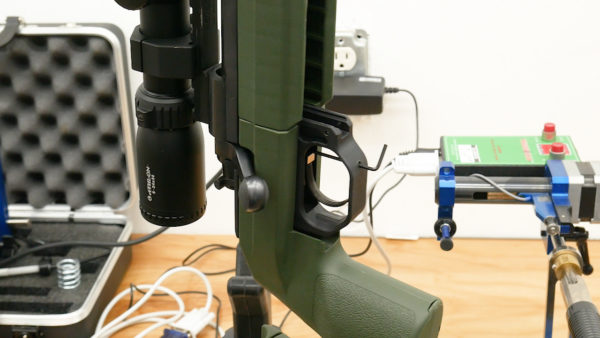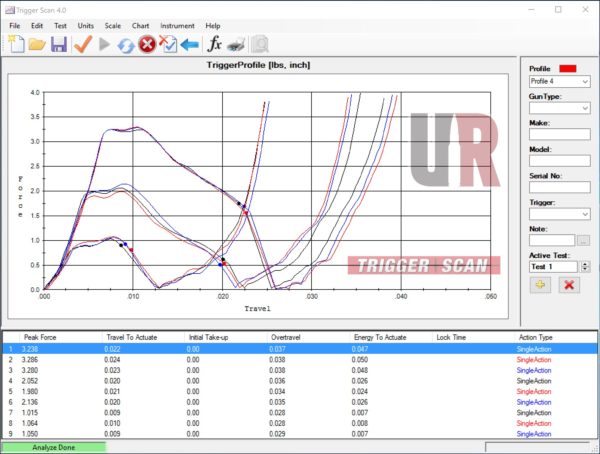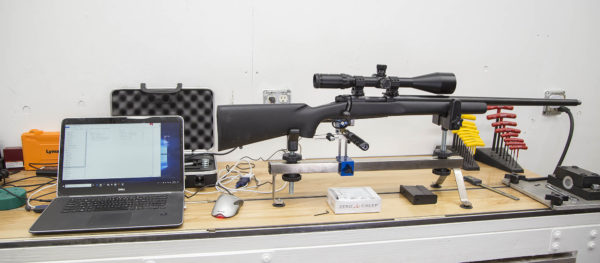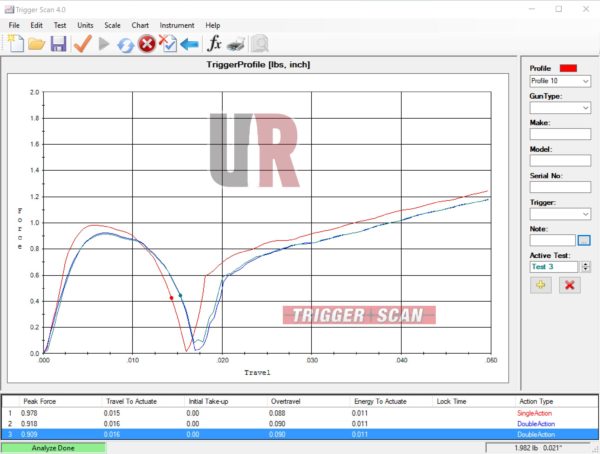I’m really liking the custom Remington 700 rifle I built chambered in 224 Valkyrie. One of my favorite things about this rifle is the trigger, a TriggerTech Special drop-in for the Remington 700. If you haven’t already, you’ll want to check out the post and video where I installed the TriggerTech Special, and the KRG Bravo stock. In this post, I’ll put this new trigger to the test using my Trigger Scan TS-11 from DVORAK Instruments.
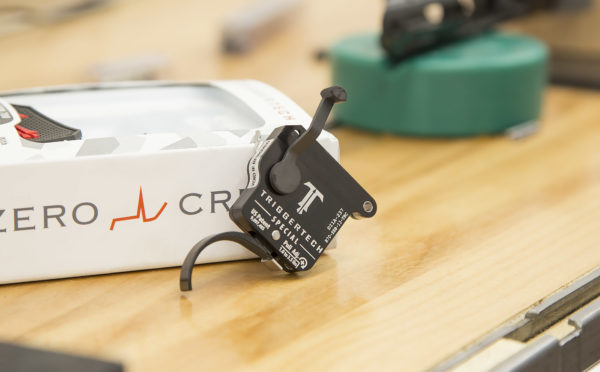
Above you can see what the TriggerTech special looks like before installation. It’s essentially a drop-in sealed unit, and there’s only one screw for adjusting the pull weight setting. This trigger features an integrated safety and bolt release, so it’s literally “plug and play”.
Trigger Scan Test Setup
This was the first time I mounted a rifle in the DVORAK Instruments Trigger Scan TS-11, and it took a bit of fine-tuning to get repeatable results. Converting from a pistol setup to a rifle setup for the Trigger Scan TS-11 involves removing the pistol rests, and installing rests that hold the rifle buttstock, and the forend. I also found it necessary to remove the buttstock bottom plate on the KRG Bravo stock in order to get the rifle level, and to remove the magazine catch in order to clear the Trigger Scan load cell housing. You can expect this kind of fiddling when running these kinds of “scientific” tests.
Since this is a sensitive laboratory instrument, it’s important that there’s no “slop” anywhere in the setup. Otherwise, you’ll get erratic results when you go to scan triggers.
Once I got things “clamped down” good, and everything dialed in, I started to get some really good and consistent readings. For my testing, I decide to focus on three pull weight settings: minimum, middle-value, and maximum. I carefully counted the total number of “clicks” (heard when you turn the adjustment screw) and found there were a total of 44 clicks.
That translated to the following trigger pull weight settings:
- Minimum: screw turned all the way out, then turned in until one click is heard
- Middle: 22 clicks in from minimum
- Maximum: 44 clicks in from minimum (that’s when the screw stops)
During the KRG Bravo stock install, I drilled a small hole that enables the pull weight to be adjusted without removing the barreled action from the stock- a feature that proved quite handy for these tests (which I ran a total of 3 times):
TriggerTech Special Trigger Scan Results
For each pull weight setting I ran three tests to ensure accurate and repeatable results were obtained. In the graph below, you can see how consistent the results were:
Click/Tap to enlarge
From this data, we have the following:
Peak Force (pull weight)
| Test | Min Setting (lb) | Mid Setting (lb) | Max Setting (lb) |
| Run 1 | 1.015 | 2.052 | 3.238 |
| Run 2 | 1.064 | 1.98 | 3.286 |
| Run 3 | 1.05 | 2.136 | 3.28 |
| Average | 1.043 | 2.056 | 3.268 |
Other Metrics
| Min | Mid | Max | |
| Take-Up | 0.000″ | 0.000″ | 0.000″ |
| Travel to Actuate | 0.009″ | 0.020″ | 0.023″ |
| Overtravel | 0.028″ | 0.035″ | 0.038″ |
For perspective, you have to take a look at the units on the graph- the travel (distance) axis shows less than 0.040″ total movement, and peak force is realized with only about 0.005″ trigger movement! We are really “Zoomed in” on this graph compared with a typical scan for something like a common pistol (with 10x the movement), or military spec AR-15 where there could 0.100″ total movement.
One of the things I couldn’t quite understand from reading the graphs for the TriggerTech special, was the “ramp-down” after the trigger break event. After discussing the issue with TriggerTech, getting more information from their engineering team (including comparing Trigger Scans) they were able to clear things up.
Here’s the summary from the TriggerTech engineering team:
The main difference between a friction based trigger and ours is that once the break has happened we have an engineered camming action that speeds up the trigger lever and essentially out paces the trigger finger. Because our test rig and the Dvorak operate in displacement domain and not speed domain the curves tend to look a little strange as compared to all other triggers. In an friction based trigger (which most other triggers are) the force drop is instant as the break occurs because the parasitic friction between the engagement surfaces is gone once the break happens. In what I call scaffolded triggers like the Jewel the force stays relatively constant after the break until the over travel stop is reached.
Current testing methodology [Ours and Dvorak] are good at measuring creep before the break which is usually manifested by a flattop that looks like a rocky road due to the stick slip that occurs when two surfaces slide. Once the break occurs neither of them will accurately reflect what the trigger finger feels until the overtravel stop is reached.
On the graph the initial slope until the break is just elastic deformation of the overall structure (both the test rig and trigger). That’s why the displacement is linear with the pull weight increase.
Note worthy is that the actuation distance and lock time measurement on the Dvorak are calculated based on an algorithm that uses the force drop after the break on a friction based trigger. This measurement (from the DVORAK Trigger Scan) cannot be used for the TriggerTech triggers. It appears [from the Ultimate Reloader test] the Dvorak trigger actuator may not be centred on the trigger lever which is likely causing the double peak on the graph.
Based on my experience using the TriggerTech special in the field (where I run it at minimum pull weight), I would say my first-hand impressions are consistent with the data gathered here. The TriggerTech Special trigger pull is well-defined, and clean. It’s also very consistent: and that’s something that’s super critical for precision rifle shooting.
For Comparison: Rifle Basix Winchester 70 Drop-In Trigger
I thought it would be interesting (and helpful) to take a look at another similar trigger for comparison. I decide that my Winchester Model 70 would be a good match with its Rifle Basix drop-in trigger. So I repeated the same tests, but with only one pull weight, about 1 lb.
And here are the results from the three passes at about 1lb pull weight setting:
As you can see in the graph, these two triggers (the TriggerTech Special, and the Rifle Basix) have similar trigger pull characteristics with a couple minor differences:
- The Rifle Basix trigger pull is just a tad less “defined” (rounded trigger pull force profile)
- The Rifle Basix results are somewhat less consistent (two visible lines for trigger actuation)
Don’t get me wrong, I love the Rifle Basix trigger, it performs quite well.
Conclusion
The TriggerTech Special has exceeded my expectations. The installation was very straightforward (no extra parts needed), and It shoots great. I find my self thinking less about the trigger when shooting this custom Remington 700, and instead focus more on my posture and the target itself. And that’s a good thing! It’s also good to know that I can turn up the pull weight in just a few moments if I need to for any reason- perhaps when packing the rifle during a hunting trip.
If you are looking to own your own TriggerScan TS-11 setup, I can save you some money! (special offer for gunsmiths, schools, journalists, and other non-commercial businesses/organizations). If you are interested, please use my contact form to send me a message!
Do you have a TriggerTech trigger? I’d love to hear about your experiences! Please leave a comment.
Thanks,
Gavin
